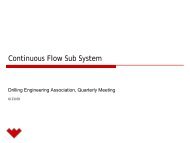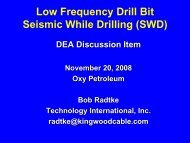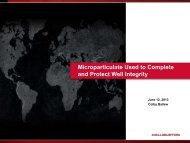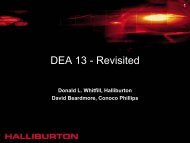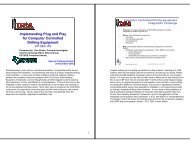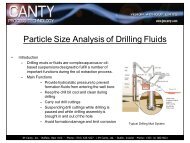JCPT-paper-on-Sag - Drilling Engineering Association
JCPT-paper-on-Sag - Drilling Engineering Association
JCPT-paper-on-Sag - Drilling Engineering Association
Create successful ePaper yourself
Turn your PDF publications into a flip-book with our unique Google optimized e-Paper software.
FIGURE 2: Pressure changes for a stable mud (mud A) understatic test c<strong>on</strong>diti<strong>on</strong>s. The pressures in both pipes are identical.pressures, respectively. The pressure range of the high precisi<strong>on</strong>transducers (H<strong>on</strong>eywell ST 3000) was 25 kPa with an accuracy of± 0.1%. Filled with a 1,500 kg/m 3 mud the hydrostatic pressurewas 15.5 kPa, meaning that the accuracy for the <strong>Sag</strong> Tester wasapproximately 0.2% when filled with this mud. Data measuredfrom all sensors were taken at time intervals from <strong>on</strong>e to 10 minutes,for periods up to 15 hours.The experimental set-up is based <strong>on</strong> the idea that changes in thedrilling mud density as a result of segregati<strong>on</strong> will cause pressurechanges in the mud column. If the mud is stable, the hydrostaticpressure will remain c<strong>on</strong>stant, and there will be little or no differencebetween the collector and the bottom pressure.In the case of an unstable drilling mud, even though it had gelstrength higher than the minimum to avoid settling, a barite bedwill form <strong>on</strong> the lower side of the inclined pipe. This process willcause a reducti<strong>on</strong> of the drilling mud density, and a corresp<strong>on</strong>dingreducti<strong>on</strong> in bottom and collector pressures. The pressures measuredat the bottom of the two pipes will decrease in a similar wayand will be nearly equal for both. If the solid particles accumulated<strong>on</strong> the lower side start to slide, they will fall into the collectorpipe due to gravity and stay in suspensi<strong>on</strong> for up to several hoursbecause the settling distance is large. The increase of the weighingmaterial c<strong>on</strong>centrati<strong>on</strong> in the collector pipe will increase the muddensity and thus the hydrostatic collector pressure. The pressure inthe collector pipe will differ from that in the inclined pipe; it willdecrease less than the bottom pressure or it will remain c<strong>on</strong>stantor even increase if the mud is very unstable. A difference betweenthe collector and bottom pressures will indicate an unstable mud.The stability behaviour in the sag tester will then be:• Stable mud: collector and bottom pressures are almost c<strong>on</strong>stantand close to each other. Stable, static mud behaviour isplotted in Figure 2 and 3.• Unstable mud: collector pressure is higher than bottom pressuresand both are decreasing with time. Typical pressurebehaviour of an unstable drilling mud under static c<strong>on</strong>diti<strong>on</strong>sis shown in Figure 4.As seen from the two plots the stable mud shows no changes inthe measured collector and bottom pressure, while the unstabledrilling mud shows a pressure difference around 2% after threehours, and a collector pressure that is nearly c<strong>on</strong>stant.As a quality c<strong>on</strong>trol, the sag tester was initially calibrated withwater which, as expected, showed c<strong>on</strong>stant pressures.Laboratory test proceduresFor most of the tests a commercial mud, supplied by <strong>Sag</strong>aPetroleum was used. Its data are shown in Table 1. This mud wastreated with water, prehydrated bent<strong>on</strong>ite, Na 2 CO 3 and barite indifferent porti<strong>on</strong>s to vary rheology and thus stability. Prior to teststhe treated mud was aged for 24 hours. Static tests were run for upto 12 hours while the flow tests were run for 2 hours, which wasFIGURE 3: Pressure changes for a slightly less stable mud (mudB) under static test c<strong>on</strong>diti<strong>on</strong>s.FIGURE 4: Pressure changes for an unstable mud (mud C) understatic test c<strong>on</strong>diti<strong>on</strong>s.found to be sufficient to characterise the mud. The rheology andgel strength parameters were measured with a Fann rheometer (11) ,and the density with an API mud balance (11) .Four different tests were run; static, pressure pulsing, pist<strong>on</strong>agitati<strong>on</strong> and pumping of mud. In the static tests, the mud waspoured into the sag tester and then left undisturbed. To simulatethe effect of pressure surges which in the wellbore are caused byan accelerating and decelerating drill string, a pressure pulse of0.1 MPa was applied to the top of the tester. Sharp pulses wereapplied every 2.5 min during the time frame from 1.5 to twohours. To simulate tripping operati<strong>on</strong>s and the effect of drill pipe,tool joints, stabiliser and bit movement al<strong>on</strong>g the wellbore, ametal rod with a pist<strong>on</strong> (OD = 30 mm) in fr<strong>on</strong>t was moved outand in of the inclined pipe every 2.5 min. starting 1.5 hours aftermud was poured into the <strong>Sag</strong> Tester and lasting for 0.5 hour. Thepurpose of pulse testing was to investigate if barite sag would beaccelerated by small disturbances in the mud. During the flowtests the mud was circulated from the bottom of the inclined pipeusing a centrifugal pump at a c<strong>on</strong>stant flow rate giving a speed ofabout 0.15 m/sec. In all flow tests the Reynolds number rangedbetween 500 – 1,500.ResultsIn all, more than 200 tests were carried out and the pressureplots presented here are typical behaviour of stable and unstablemuds. All data from the experiments with the <strong>Sag</strong> Tester are plottedas per cent pressure change from the initial pressure versustime. Fluid properties for the test results presented in the graphsSpecial Volume I 3



